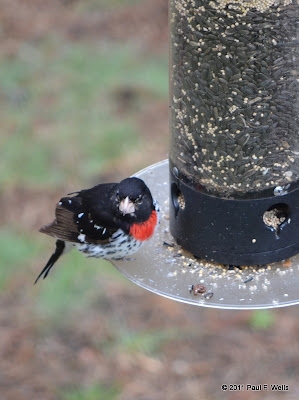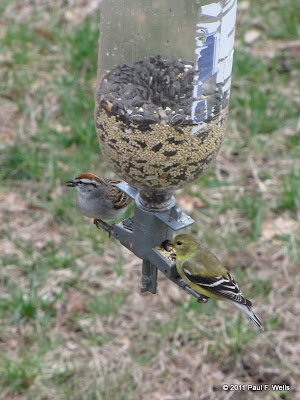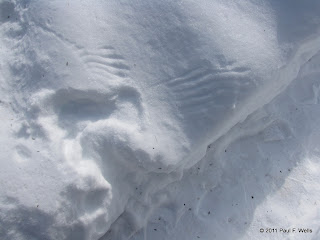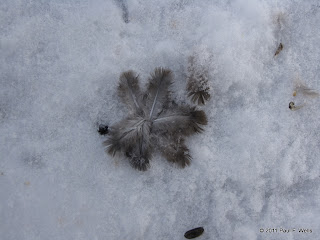Ah, early May -- the birder's favorite time of year, when there are lots of migrants returning or at least passing through, and the leaves are not yet out on the trees so one can actually see the birds without a lot of hunting! Today, without trying and with hardly going outside the house, I tallied 26 different species. Some of these are The Regulars, but that's still a pretty decent total.
We've had a good variety of warblers bopping around the trees on the edge of the yard, but even without full foliage there have been several that I've been unable to identify, simply because they dart around so much. But right around the house we've had Blackburnian, Black & White, Yellow-rumped, Chestnut-sided, Black-throated Green, Palm, and an American Redstart. If I include the area down by the river I can add Yellow Warbler and Common Yellowthroat to the count. I was particularly pleased to see the Redstart this morning. I note that the first one we saw at this house was on May 8, 2010. As Sally said when I pointed this out: "Punctual little sucker, ain't he?" Last year some Scarlet Tanagers had shown up by this time but I've not seen any yet this year. Yet.
All the colorful returnees that I reported on in my previous post are still around. The male Baltimore Oriole has been joined by a "first spring" female so, perhaps with a bit of luck, they'll decide to take up nest-keeping in the area. The Rose-breasted Grosbeaks are chasing each other around the yard and woods, presumably with amorous intent.
We were very pleased to hear our first thrush of the year singing yesterday morning as we retrieved the Sunday papers from the end of the drive. I think it was most likely a Hermit Thrush, like the one pictured in the header to this blog, but I'm not certain. After hearing it we promptly gave ourselves a refresher course in distinguishing thrush songs, but since then I've not heard him singing again to confirm his identity.
The downside of the seasonal change is that birds that were around all winter have now departed. I've not seen and Juncos for a couple of weeks now, and Red-breasted Nuthatches are likewise among the missing.
Tree sparrows are also becoming scarce, though I seem to recall that last year we had some around through the summer. On the other hand, a couple of White-crowned Sparrows were in the yard last Thursday, May 5, though I've not seen them since. I did manage to get a few photos of one, including one of him together with one of the many White-throateds we have so the differences between the two are easy to spot:
"See, I've got a pretty white throat..."
"...and you don't!"
There are three or four Gray Catbirds around, and are very active and very vocal! We had a pair or two nesting around here last year, and we hope they take up residence again. They seem to be hanging out in a brushy area on the northeast side of the house, which looks like textbook Catbird habitat to me! But what do I know. They're quite happy to help themselves to the orange halves that I put out for the Orioles:
They also love to feast on suet:
The Ruby-throated Hummingbirds are also still coming around, and I managed to get a couple of shots that are somewhat better than those in the previous post:
Blue Jays are with us all year, of course, but their numbers have gone up noticeably in the past week or two. I haven't bothered to count, but whereas there are usually three or four around, there's at least twice that many now. I fear that I've tended to overlook them in terms of photography, but they really are handsome birds and deserve to have their picture taken occasionally!
The local mammals are more active again, too. Chipmunks were largely absent through the winter, but have resumed their scampering around the yard, and have dug a few new holes in the lawn and under steps. Hmmmm.
Finally, right after hearing the thrush singing yesterday we noticed something large and furry in one of the small trees in the woods near the garage. "What the...????" Turns out it was a chunky porcupine, who gave the impression that he was sleeping off a bender from the night before:
His impressive, orange-colored incisors are clearly visible in the last photo if you click on the small image and pull up a larger copy. One has to wonder why he chose this particular tree in which to catch up on his beauty sleep. It seemed barely stout enough to hold him, and it didn't look particularly comfortable! But what do I know. He was largely unperturbed by the process of having his picture taken and remained asleep all the while. He finally sauntered off sometime while we were having breakfast, though I missed seeing him climb down.
There were many old apple trees on the farm where I grew up, including several right around the house. Once they began to bear fruit each year the trees were magnets for porcupines! The family dog would usually take exception to their presence, often resulting in an encounter in which the dog ended up with a nose full of quills. One of my older brothers remembers a cow getting quilled on at least one occasion, but that must have been before my time.
Porkys don't shoot their quills, as is sometimes believed. However, the quills are attached very loosely and are dislodged quite easily. Writing of the porky's ability to defend itself, Alfred J. Godin, in Wild Mammals of New England (1977) notes: "A cornered porcupine erects its quills, tucks its head between its front legs or under a protective object, turns its rear to the adversary, and rapidly swings its tail or makes a rolling lunge of the body." Given that porcupines' top forward speed is only around two miles per hour they clearly need some sort of defense mechanism.
There were many old apple trees on the farm where I grew up, including several right around the house. Once they began to bear fruit each year the trees were magnets for porcupines! The family dog would usually take exception to their presence, often resulting in an encounter in which the dog ended up with a nose full of quills. One of my older brothers remembers a cow getting quilled on at least one occasion, but that must have been before my time.
Porkys don't shoot their quills, as is sometimes believed. However, the quills are attached very loosely and are dislodged quite easily. Writing of the porky's ability to defend itself, Alfred J. Godin, in Wild Mammals of New England (1977) notes: "A cornered porcupine erects its quills, tucks its head between its front legs or under a protective object, turns its rear to the adversary, and rapidly swings its tail or makes a rolling lunge of the body." Given that porcupines' top forward speed is only around two miles per hour they clearly need some sort of defense mechanism.





























































